For Depersonalization players, this guide will show you the fundamentals of this game as well as the best build to get started.
Warning: Apart from the Prologue, I won’t help with the scenarios, they are for you to explore.
I’ll just show you a good way to get started.
Introduction
Let’s start with the basis: What is Depersonalization?
To make the summary of the premise as brief as possible: It is a mystery and story-driven game about a man named Anan getting abducted by an Eldritch Being “Yog-Sothoth” to help correct the timeflow of any corruption. This premise is accompanied by some RPG mechanics, a management part, as well as DnD style of dice throw to determine if an action is successful or not. (which can range from investigation, combat, or even craft)
So, after completing the prologue, you’ll be in Anan’s shoes to manage your expeditions across time as well as your instigators. Be careful though, death will be involved.
Indeed this game is pure “die and retry” as there’s a lot of ways to die, reach an unavoidable bad ending, or get slaughtered by the monsters around you. (Just to give you an idea, your base max hp is 16, the lowest is 4, and for the creatures, the minimum is 10, and the max is a flat 100.) So when you create a character, be ready to lose them at any point.
Note: Since the game is still in early access you’ll notice plenty examples of sloppy translation, oversights in the story depending on your choices (like the Hunter in Lies and Fraud who can get separated from you then treated as a stranger in another cutscene), as well as unavailable features. (The most noticeable is called “Combat/Challenge mode” and gets “unlocked” after completing the “Lies and Fraud” scenario.) So this guide will be updated once those gets added.
Basic Movement and Investigation
The main draw of Depersonalization is to play as a normal human trying to survive, understand, and maybe solve a desperate situation akin to H.P Lovecraft’s nightmarish novels.
Well the tutorial explains the very basis pretty well:
-WASD to move (Not modifiable for now sadly.)
-F to interact
-C to see what you can interact with. (And the key items required to trigger deeper interactions)
-And the spacebar for confirmation when required.
-F11 and the escape key are for the option menu. (Allowing you to return to the lobby or quit the game at anytime. You can also activate the synthetic voice, game’s volume and other stuff.)
-By clicking on the top-left portrait of a character in your party, you’ll get the basic information on them and just a recap of their status or their traits.
-Pressing the shift key one switches your character from walking to running and vice-versa, no need to hold it.
-Finally, Tab opens the RPG menus. I’ll go over them a bit later.
Like a point and click, you want to interact with everything and everyone to make sure you’re not missing out of some content. (Speaking bubbles are white and thought bubbles are black) Most of the time, the game will warn you if you’re making a major decision by indicating which option is for the main plot, but not always sadly. Also, anytime text appear you can activate an auto mode or skip it (not recommended at all because the game does the non major choices for you depending on your character’s moral compass so you can miss content or even worse, be locked out of an ending because the non minor choices can lead to essential side quests).
Dice Rolls, Luck, and Death
Most actions require a dice check to see if you’re able to do it.
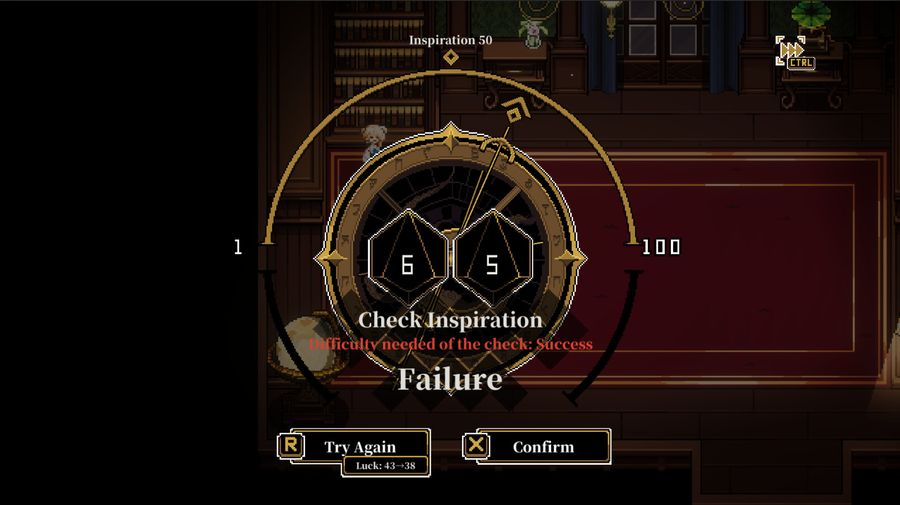
The goal is to have the lowest score possible.
You can get anything from 01 to a 100 (if you get both 0 dices)
The first dice is the most important since it’ll determine if you got 10, 20, 30 etc…
See the yellow thing on top of the gold line? That’s the stat which is checked by the dice. When creating a playable character you’ll be able to choose what they are adept at, meaning how likely it is for them to successfully pass a dice roll in one try.
Here it’s a pure 50, meaning you have 1/2 chance of getting it right.
The lowest possible is 20% chance without modifiers and the highest is 80%.
We’ll see how to create that in the instigator creation later.
There’s a second type of dice roll that can happen, the oral confrontation.
Sometime when you’re trying to convince someone with diplomacy, or need to see if someone is trustworthy with psychology, you’ll have to confront them in a dice roll.
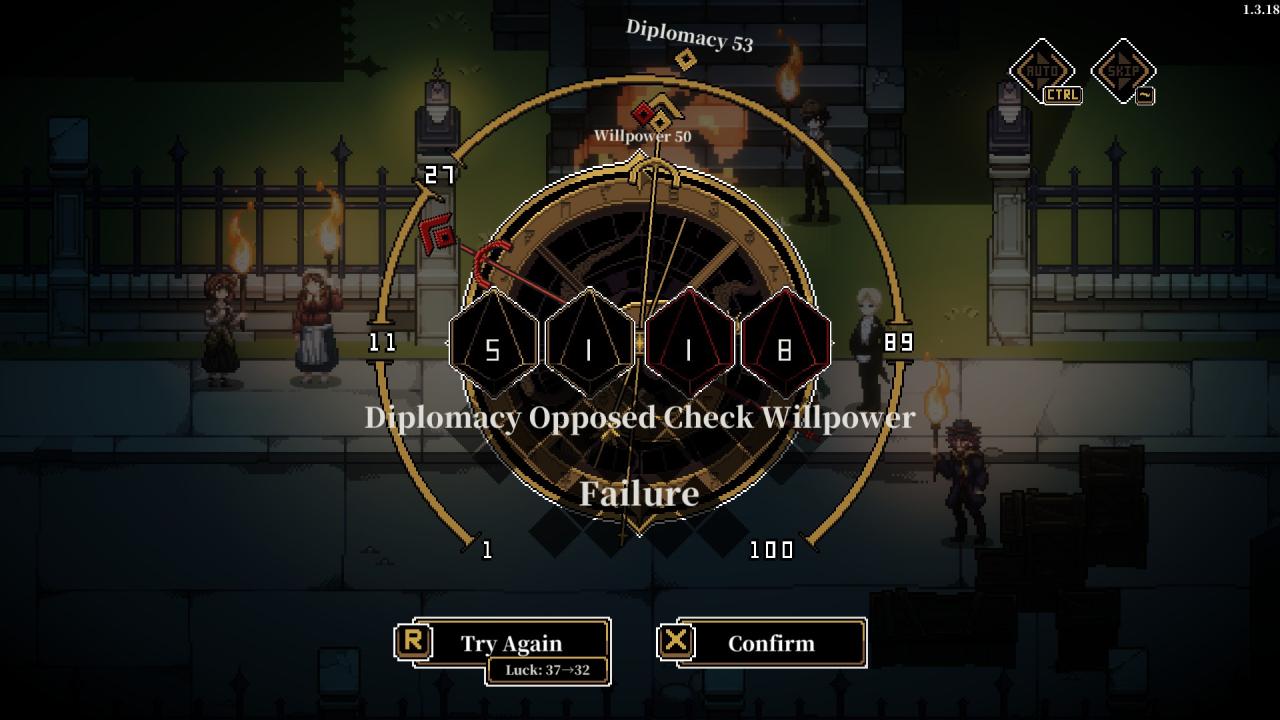
Here the opponent’s results are shown so it’s easier to understand, but they can be hidden if they’re important plot characters and you’ll only have their red arrow to gauge how much they succeeded.
These confrontations oppose two things:
-Who has the lowest dice roll?
-Who managed to succeed their dice rolls?
Basically, if one succeeded and the other didn’t, for example say, one has 60 in psychology and the other 50, well if they both do a 52 dice rolls, the one with 60 as a base stat wins.
And if both succeed or fail, that’s when the difference between the dices’ numbers matter most.
Here’s a successful one:
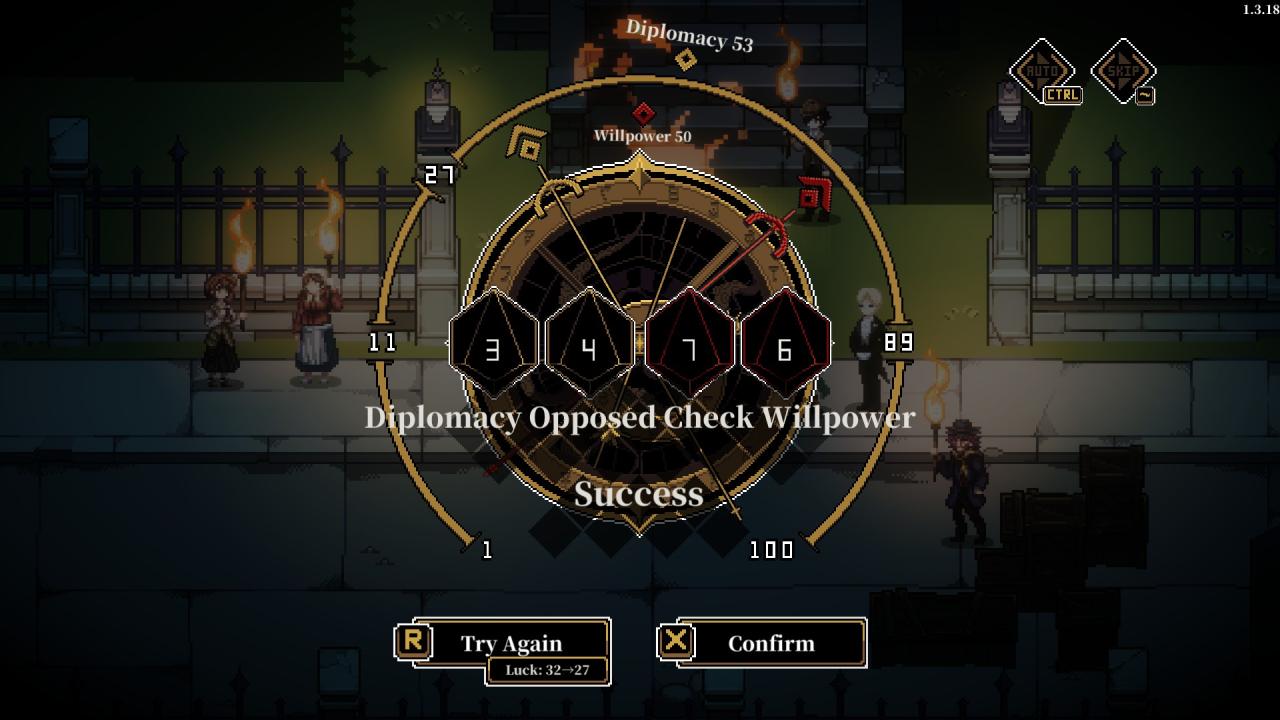
I precise that this mechanic is basically the same for fights, except depending on the spell, weapon, skill, or traits, monsters or the humans can still hit each other despite both failing their dice rolls.
Finally the last mechanic to talk about in the overworld is Luck:
Think of it as another resource like money. Except you can only get more through specific items, like the four-leaf clover, or by getting clues to understand the overarching plot or side quests. (By being a detective.) Luck can then be used to reroll investigation dice rolls or major plot actions.
Although, know that some of the dice checks are not that important, and others are even damaging if you win them. (For example, since it happens fairly early in the story, if you try to save Tonson from Horn by sneaking up on him and succeeding, the guy then immediately kills you as a reward and you have to reload.)
Speaking of which, anytime you die, you can spend a bit of time fragments (which you get everytime you clear a story, including the prologue), to retry a fight if you lost it, reload a save file, or sacrifice an instigator if you’re soft-locked because of his personality. Luckily there’s a bug where you can still leave to the main lobby, so by doing so, the loss is erased and you can go back to your savefile for free like this, and even change the instigator to retry the campaign with someone else if need be.
How to Manually Save and Navigate the Menu
Disclaimer: I don’t really have anything to say regarding the fights, they’re straightforward. Most of them require a lot of luck with the dice rolls, and some are impossible with bad equipment or a lack of magic. (The big monster at the Northern Alley in Townsend hits thrice in a row and will one-shot you for example if you can’t dodge or impede his movement. The final boss of the “Good ending” of that same route regenerates 10% of her HP each turn. etc…)
That’s why you MUST save at all time and don’t hesitate to create multiple save files to check out routes and stuff like that. You don’t even have to worry about having too many because as soon as you give up on an expedition or clear it, the save files associated will be erased. (And you can only have one active at a time.)
But how to save without relying on the auto-save? Well it’s the game menu with Tab, that I mentioned!
Here’s how it look when you enter it:
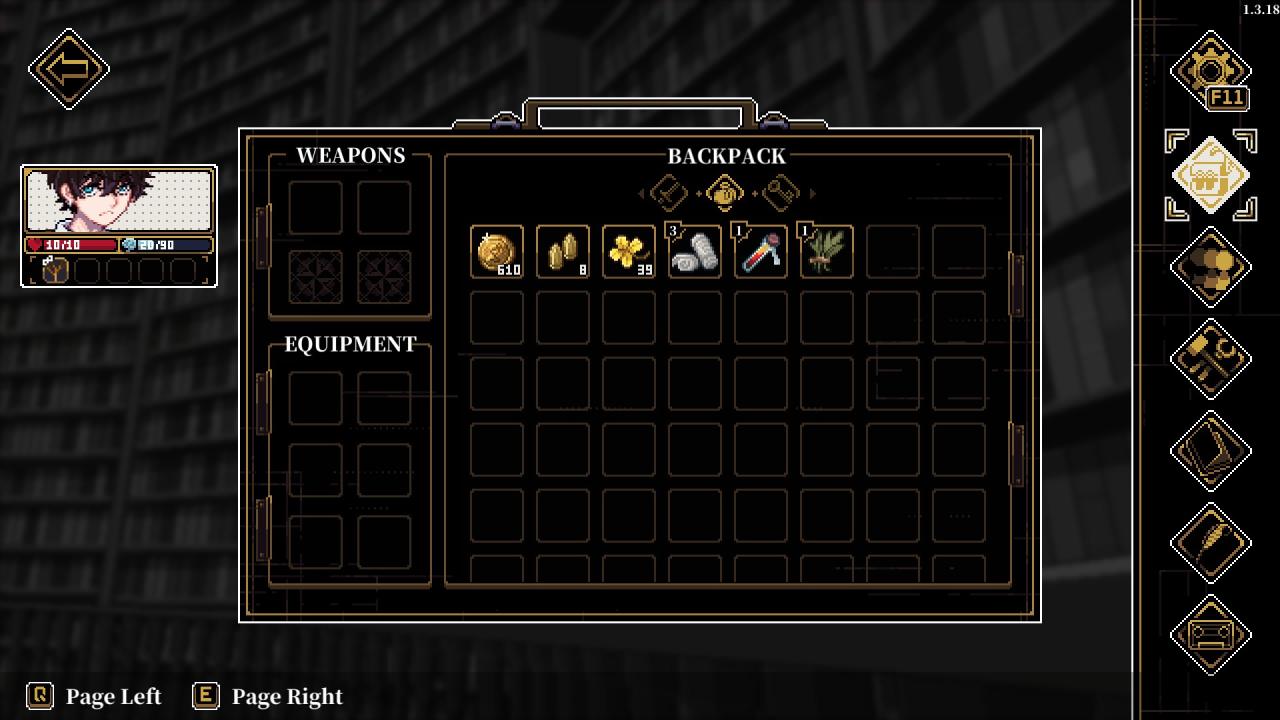
That’s your backpack with the items you collected. This section are the consumables and materials, the left icon is for the equipment and weapons, and the right one key objects (and mythical ones that are also available in the equipment section if you brought any.)
For now, it seems you can only have two weapons on you (unless there’s a trait to unlock the last two blocks) Regardless, what you need to understand is that the main weapon will be your attack and the off-hand one will only be useful if it has passive buffs. (You can check that by looking if the weapon has “equipment” on it.) More stats, some armor, heal, whatever. Also know that you can change equipment on the fly during a fight with the armor icon in the down right corner.
The only thing you can’t change during a fight is the backpack’s content of each character. Indeed, it is not shared by party members. So select “Give … to …” to trade between inventories, although know that depending on the route you’re going for, characters might get separated and their inventories will reset. (Not sure if it’s a bug or…) So only trade what you can afford to lose.
The items that aren’t related to your character’s job, or aren’t mythical, will be lost at the end of a campaign so don’t hesitate to use all consumables before the final battle/choice.
Since I already explained what the F11 does.
Let’s go over the other icons.
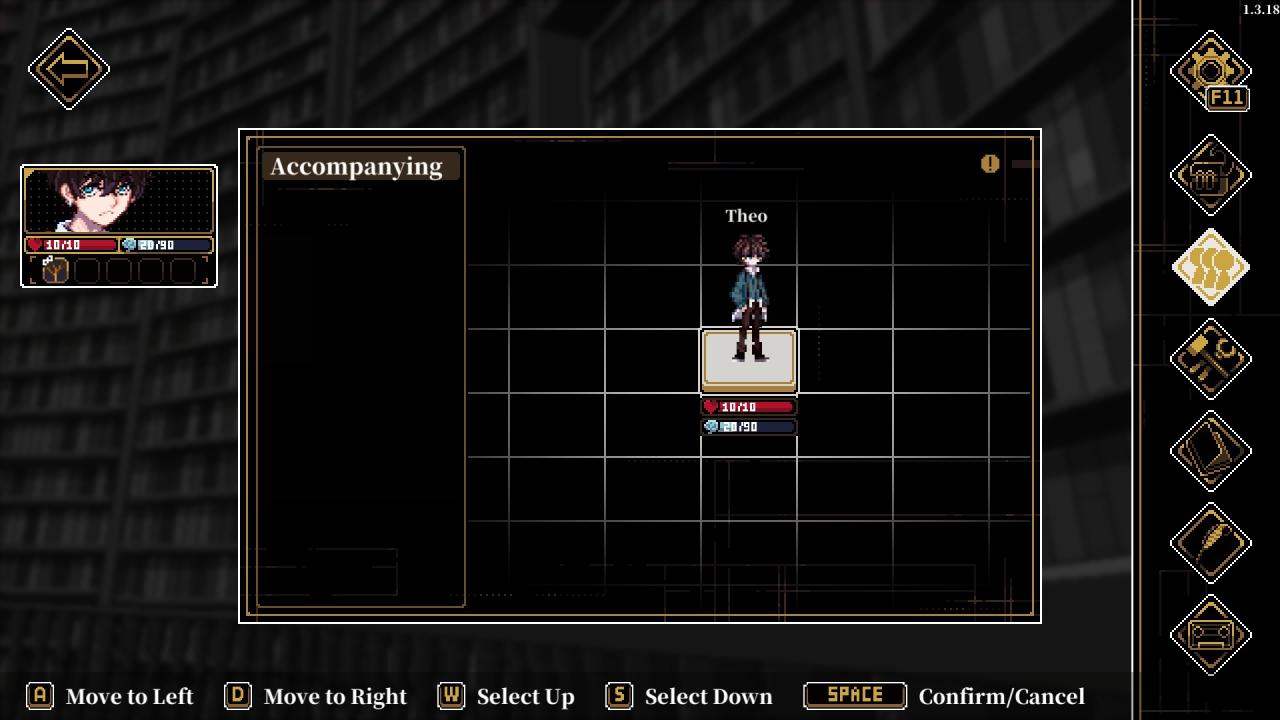
That’s just your current party. You can’t really do anything except check out the sprites.

That’s the crafting menu. Here, it’s for the equipment. The second icon leads to the consumables and ingredients. The third to the runes (equipment but mystical and two of them have limited uses). And the fourth is a quick search of what you already crafted. Each time you want to get something, you have to do a dice check. (Pretty sure they are all crafting check)
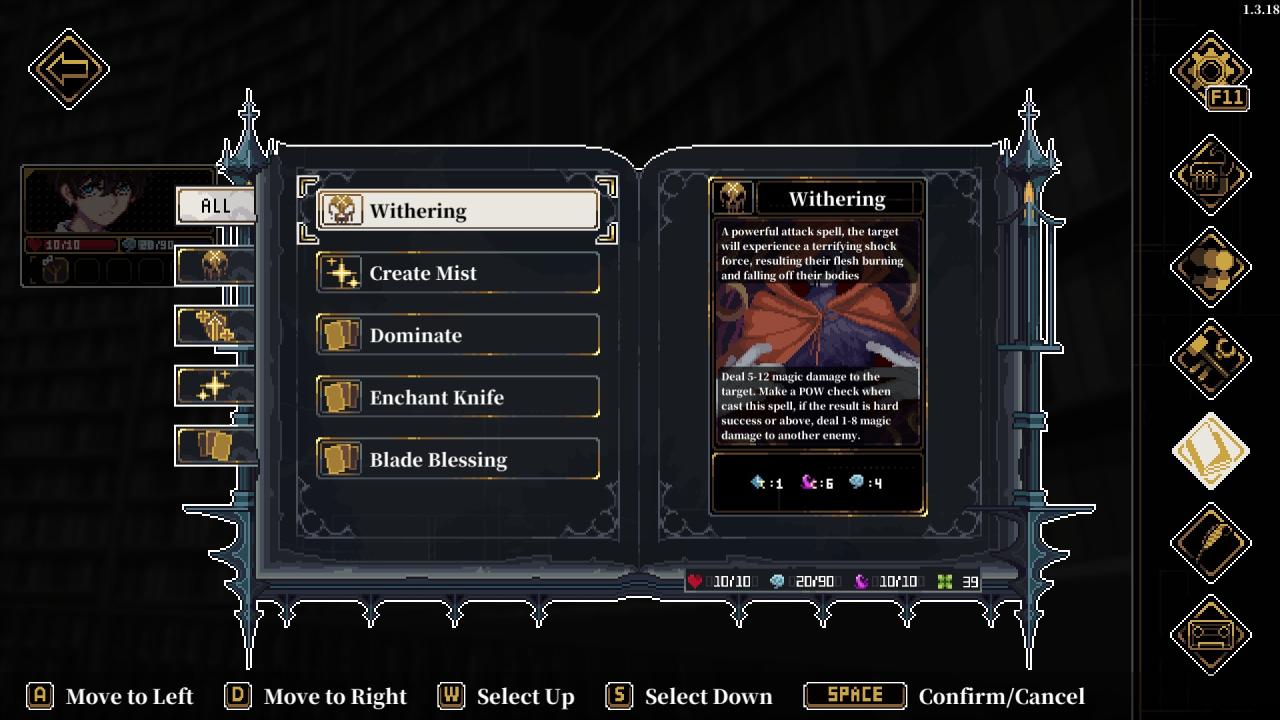
This is the spellbook. Most investigators won’t have access to it until later, or only when equipping Anan’s stick. Here, Theo, my character, is a scholar so it’s the only class that has access to so many spells right away.
The spells themselves are divided into two parts: –The overworld ones used either to prepare a battle by giving you a weapon/buffs, or mess with the NPCs to get them to do what you want.
–The battle ones.
All require both SP (Sanity/Will) and MP (Mana) to work minus the spell from Anan’s stick who only needs SP. SP only recharges if you have enough will to resist horrifying monsters, if you make choices in adequation with your character’s ideology, or if you have items for it. For MP, you simply need to run around a little and it’ll recharge over time.

This is just the clue window, where everything you learned or have done is put here. A gold patch will be marked on the left of completed quests.
If it’s related directly to the main plot it’s bright green.
If it’s blue or purple, it’s missable side content. (Again, most of the time and sometimes, like in Townsend, it can relate directly to the main plot.)
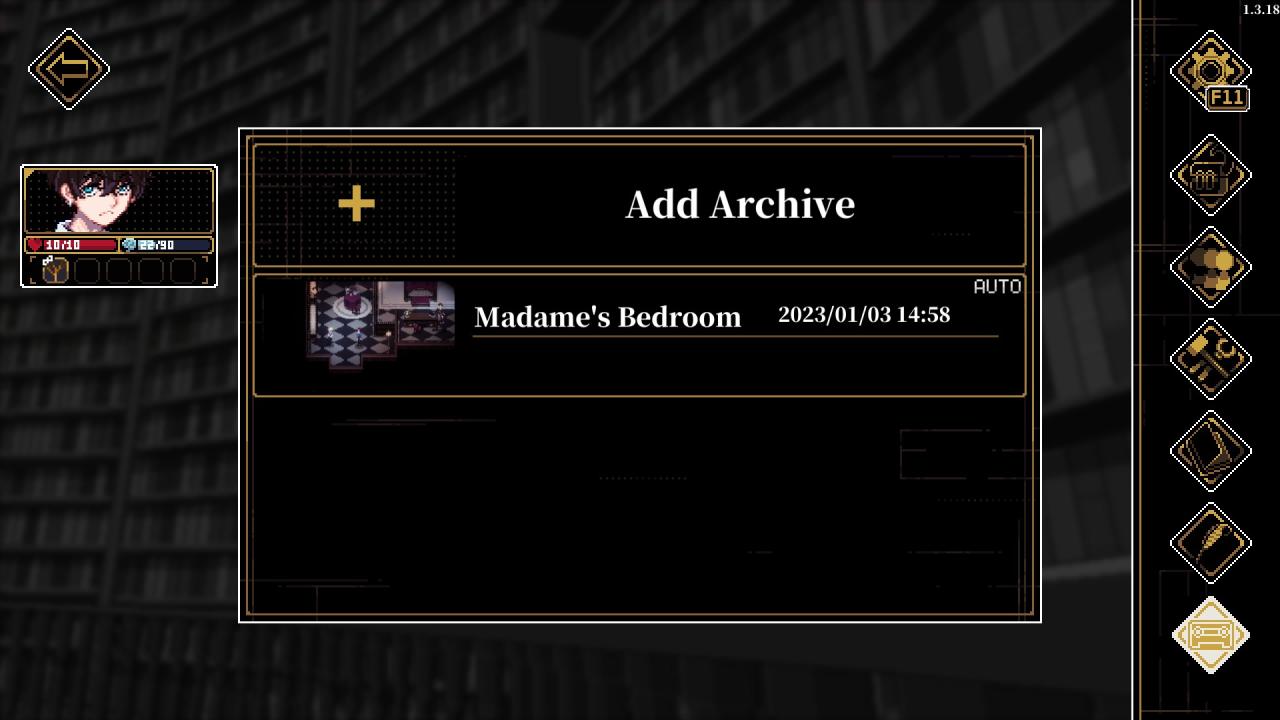
Finally you have the last important menu, the save one!
A save is called an archive and all archives related to the current investigation will be erased once you finish it and settle with the result you got.
The auto save erases the previous one done.
When you add an archive, it stays for the duration of your investigation and you can overwrite it.
Although I personally suggest to have as many as possible.
Fighting
Personally I didn’t do much research on the fighting as I always tried to avoid it with my previous characters, due to low ammo/low fighting skills, but I do know one thing: If you can craft the grenade, do it, it’s super strong but very rare.
Tips by Rai “Apex Legends” Taki:
It is also important to note that performing a weapon attack will make you attack with every equipped weapon, and you may get counterattacked if the opponent rolls a higher dodge result bracket than your attack roll. Weapon attacking with an offhand Brawl weapon is a BAD idea on a low-brawl character. Additionally, if you main hand a melee weapon it will be used for your own counterattacks if your dodge result is higher-bracket than your opponent’s melee attack roll–but the Mythic cane you get from the tutorial seems to be an exception for some reason, so gear up accordingly even on turns where you’re just using magic.
Tips by Some minor equipment-related tricks to add: you can change equipment during your turn, with no cost and no penalty (doesn’t cost actions, either). So you can, for example, walk around holding utility/unlimited durability weapons like crowbars, then switch to a gun for hard fights, and switch back when out of ammo and so on.
Stuck at the Prologue?
If you are stuck at the Prologue, Anan’s origin story, no need to panic.
The first and second part, Anan’s childhood and his life at university are all pretty straightforward. Just read the different dialogues, explore around, get familiar with the investigation gameplay, and when you’re ready simply leave the campus and go to the bridge. (There is optional dialogues, secret cutscenes most notably linked to his mother’s room, and little side quests to complete but you can just speedrun and redo the level later if you wish.)
Now for the third part here’s what you have to do. After exploring the ruins of your home, the castle, and fighting the rats, or sneaking past them with concealment, you’ll find your grandpa’s room. Here you can grab two runes hidden in the bookshelves and dodge an incoming rune. (Either way you won’t get damaged by it, even if you fail the check so don’t waste your luck.) In general, for this campaign, save your luck for the very end after the boss fight.
After doing all of this, you have a choice to make, which book on the desk to read? Well the ancient one gives you a game over, so pick the other. You’ll get teleported to a fracture of time and space.
If you go towards the future, you die.
So go back in time.
In the main corridor, if you get chased, light one of the carpet on fire, the monsters can’t reach you this way. (If you walk inside the fire and you get a burn, you can cleanse it water)
Your goal is to return to your grandpa’s room, although exploring is still a possibility. (And make sure to visit the room of Anan’s mother one last time to get the revelation of what he really is.)
Once inside, you get a cutscene and the start of Anan and Sothoth’s partnership.
She’ll ask him to flip the hourglass in the main corridor to make sure everything goes back to normal. Make sure to get equipped before trying to do so.
That’s when you’re confronted with the boss fight of the prologue, Afogomorn. (who’s basically the ender of time and Sothoth’s… rival/friend? It’s a bit confusing.)
In this fight, Anan’s completely outmatched but you can win.
You have two godly powers to help you: “Truth” and “Future Prediction” as well as your first two mythical items “Recita Stick” and the revolver.
To win you’ll have to kill Afogomorn’s avatar and not die more than seven time.
Basically, anytime you die, “Truth” restores your body and put you back at full health. But it also increases a stack, one that is also affected by the weird arrow from the eldritch god. If you get hit 8 times by the arrow/die 8 times, you get erased from History and a game over.
Since she has no armor, don’t bother attacking her with the melee weapon. Instead, put the revolver as the main weapon and the stick on the off-hand. It does a bit more damage and doesn’t require ammunition. (Although you can only shoot it six times.)
Now, to win, you’ll have to quickly deal damage. You can heal for free between turns but don’t bother blocking, spam the magic attack and the revolver for maximum damage.
Afogomorn’s attack pattern is always the same: Magic => Magic => Arrow.
Since she’s faster than you, if you need to block the arrow because you’re running out of extra lives, do it in advance, so start to cast it on her second base magic attack, and you’ll get protected from the arrow on the next turn.
After winning, hopefully, you’ll have a sequence where the game asks you to get a critical success. (between 1 and 5) To survive the possession. Luckily even if you have no luck for reroll, and fail the subsequent rolls even with Sothoth’s encouragement, you won’t die and the prologue is done.
The Hall (Lobby) and its Usage
The lobby, as its name implies, is your main hub. This is where you’ll always start and end an investigation. Controlling Anan, who now sports sick blue hair, his grandfather’s cane and some sort of tuxedo, you can roam around and get to work as soon as you’re done with the prologue.
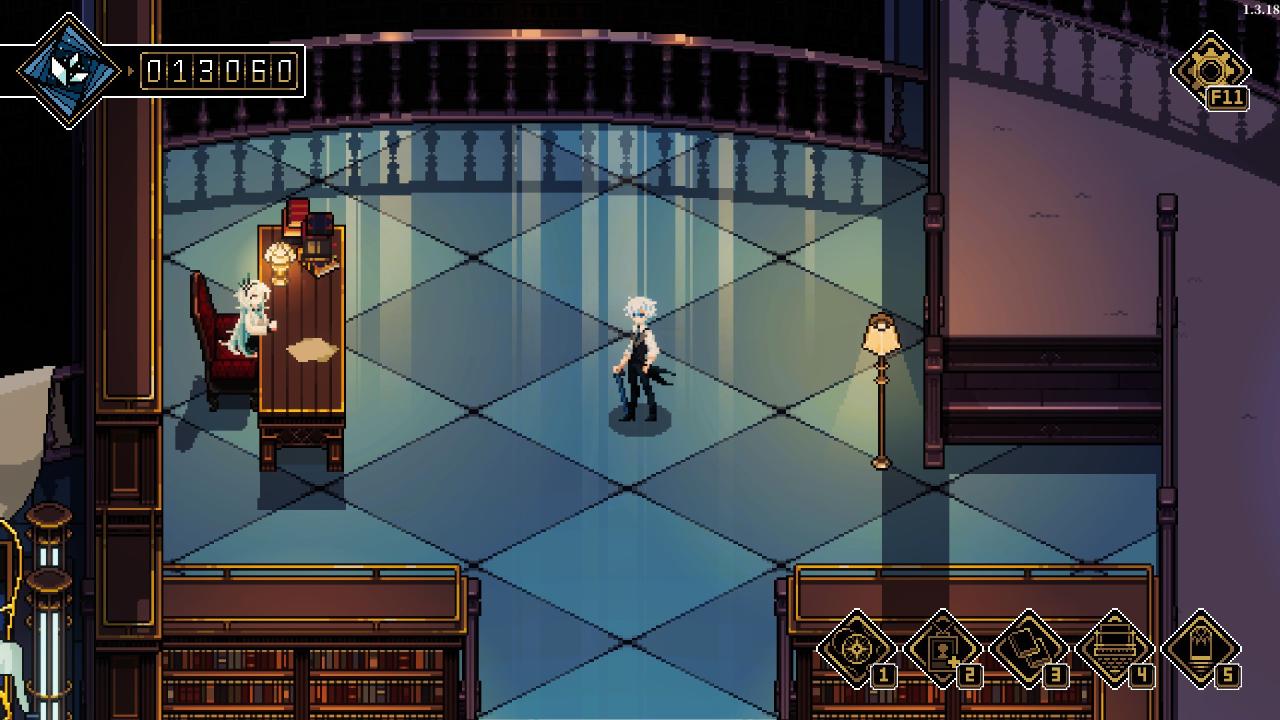
In the top left you can see your numbers of shards and this is approximately how many you’ll have once the prologue is over. These can be utilized in numerous ways, notably as retry buttons or save realoaders when you die during an investigation.
But notice the little symbols with buttons in the down right corner.
These serve as quick travel to the main locations you’ll need to go to, in order to prepare an investigation, create characters, or manage said characters in-between their missions. When pressing the corresponding key, Anan will teleport to them. So let’s present them in order.
Firstly, there’s Sothoth’s desk. (I’m next to it in the above picture and here’s what you see when you interact with it.)
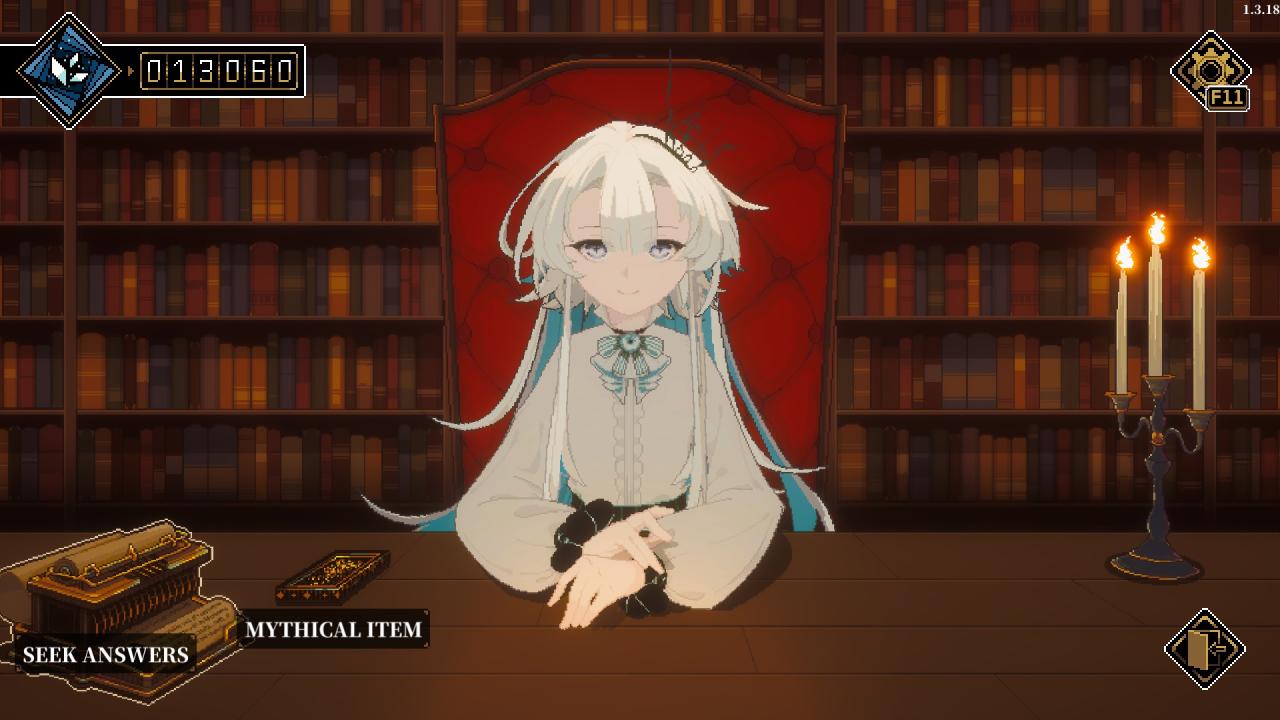
You can do three things here.
–“Seek Answers” is for new players. It should get the basic information and lore across.
–“Mythical Item” refers to the different plot important equipment you’ll have collected over a campaign. When you click on it, Sothoth will present the cards corresponding to everything you got (which you can see in the “Mythical Items” section after clearing a campaign), and let you pick one to embark for free. You can add two more for 1000 and 2000 shards respectively. This way, these items will be in the possession of your detective for their next adventure giving them a notable advantage. (No matter if they’re freshly created or not)
After clearing the prologue immediately click on it and embark Anan’s weapons. They are pretty good and will be valuable for your first real campaign.
-The last option isn’t seen on screen but it is on our right. It’s simply “Give up on investigation” and lets you stop for free, without sacrificing your character, the current investigation. You’ll lose all archives but are now free to pick new Mythical Items. Indeed, you can’t change them in the middle of investigating.
Now, the location associated with 2 is essential. It is the character/instigator creator!

As Anan puts it here:
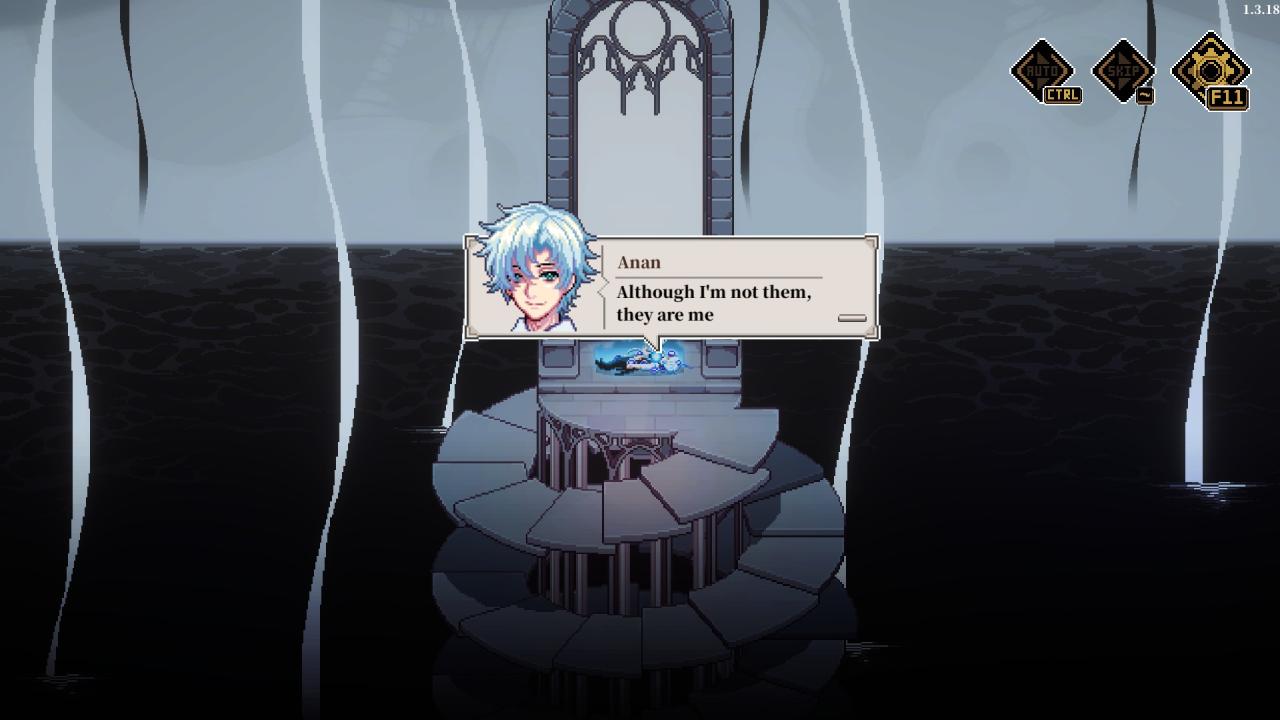
We are actively creating the story of human beings, and live as them. Anan is the original, and he forgets his memory to become said human, but in the end they always gain some form of independence from him. It’s probably where this game gets his name. (Also that technically means Anan can both be a woman and a boy, so that’s pretty metal.)
However, the system itself is really complex so I’ll give it its own dedicated section.
The third important location is a shelf full of different books.
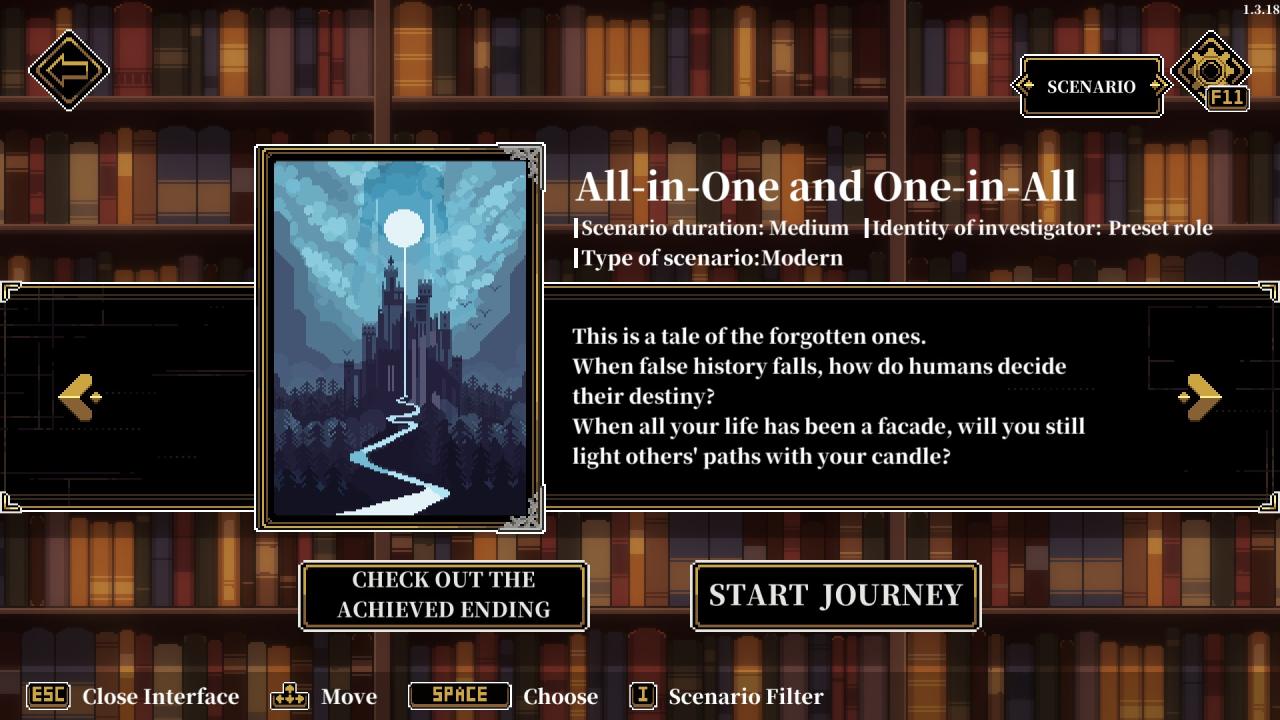
This is the level selector. You can view which ending you got and what granted you shards, or restart/start playing it. Pretty straightforward. (This is the Prologue by the way.)
I’m actually not sure of the name for this location. It seems to just be called “Side Story”. Basically it’s a giant machine that will help you with managing your instigators between each story.
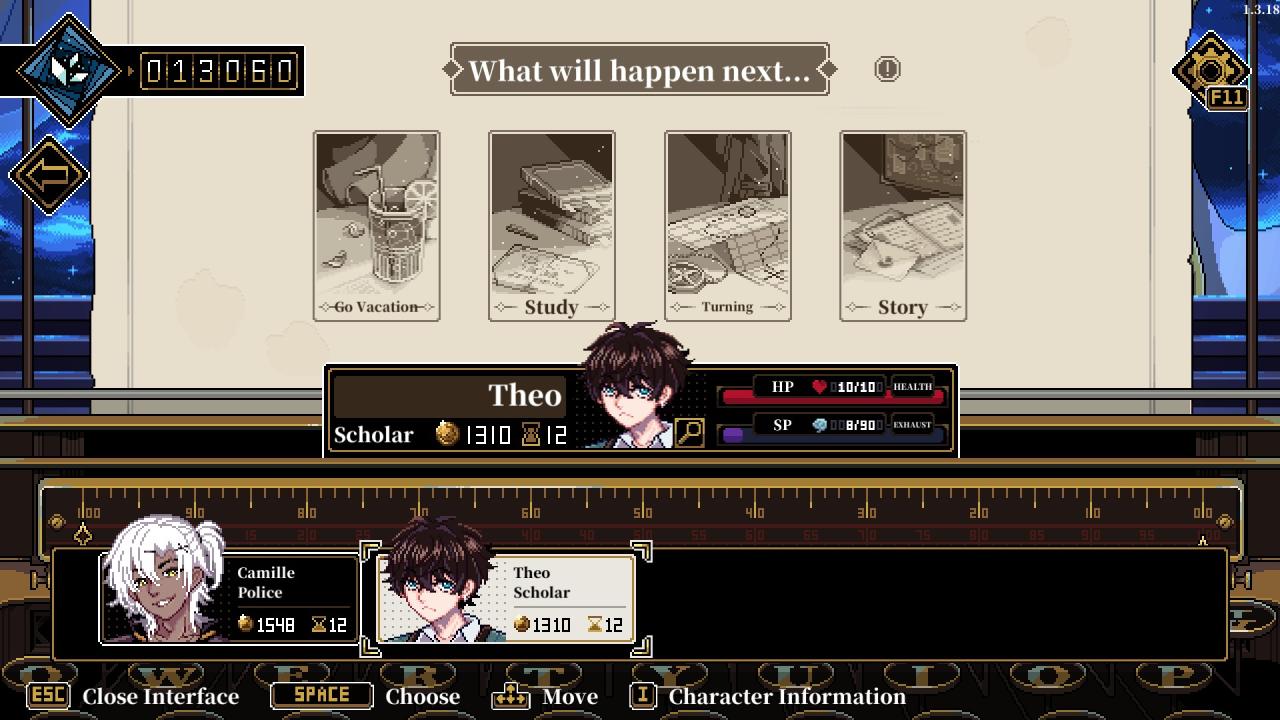
You see just as much as your characters gain traits and powers over the course of their adventure, they’ll also lose a lot. It can be health or sanity/willpower (although in this image the drain wouldn’t have been as bad if I simply used every consumables in my inventory before leaving), but it can also be luck.
As you’ll see, when creating an instigator they can start more or less blessed by Lady Luck. However, throughout an adventure, there’s no way you’ll get every dice rolls right the first time, even if the stats of your character have greatly increased through repeated usage. So the luck will drain and it will NOT be replenished to its original state. You have to farm for it with this.
These different drawbacks encourage the player to create multiple characters. (This screenshot was taken after two completed adventures, one for each.)
Here’s how it works:
-With the gold of your character, which is not shared, and the hourglasses that represent his free time, you’ll send him on different activities. These activities can be failed or succeeded with a dice roll. The only exception seems to be the last option, Story, which costs shards instead.
–Vacation’s paid options are purely to recover. It does have time-consuming but free options to farm some money among other things.
–Study serves as a stat increase. Some aptitudes are grouped together, so they only augment 5 points each, and the rest is a flat 10 per successful training. Although, the more adept a character is, the higher it costs obviously. Sadly if you fail, your character gets a negative trait. Luckily it can remedied, but it’s a harsh penalty in my opinion.
–Turning as his name indicates turn your character’s traits into something else. That’s how you get rid of bad traits. Not sure how the pricing works though. (“Windfall” only costs four hourglasses and no money for example.)
–Story costs 200 shards to play. If you pay, the game becomes a text-based adventure where you explore a cabin, you can choose which cabin to explore prior to paying. Careful though, you can quickly lose a lot of sanity, blow all of your character’s luck, and find nothing interesting. (Luckily, if you die the story just ends, there’s no penalty beyond the stats drop you got in the way.)
The last location is the gate to space and time travel. You can only use it when an investigation is ongoing and that’s how you go back to your archives/saves after leaving to the lobby.
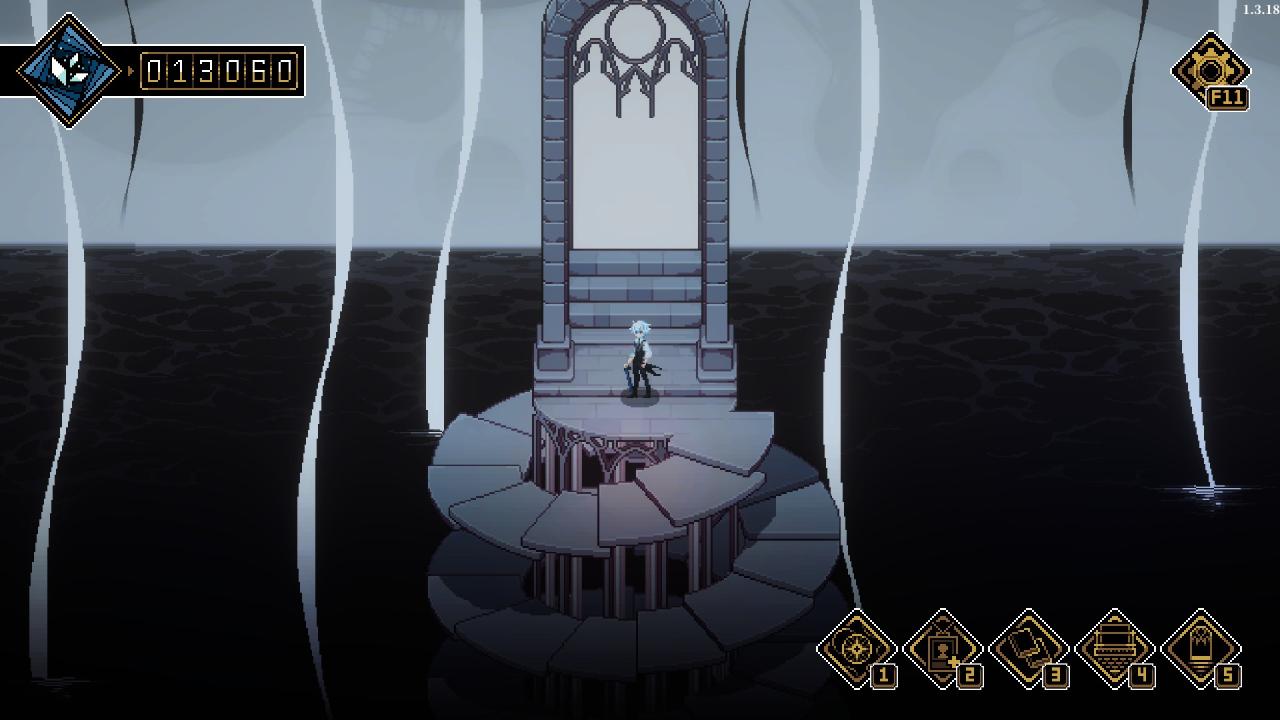
That covers everything available right now.
Creating a Newbie-Friendly Instigator
What makes a good instigator?
Well, they need to be good detectives, knowledgeable, familiar with supernatural stuff, athletic, good at fighting in general, have the basis of medicine, be diplomats, etc etc…
Yeah, everything is pretty much vital in some ways. That’s why you can never drop something to zero. Otherwise you’d be stuck or unable to get the chance to find some things.
However, after multiple attempts at building a solid character, trying out every roles and all, I can safely affirm what is a good instigator to start the game. (Before getting more experimental)
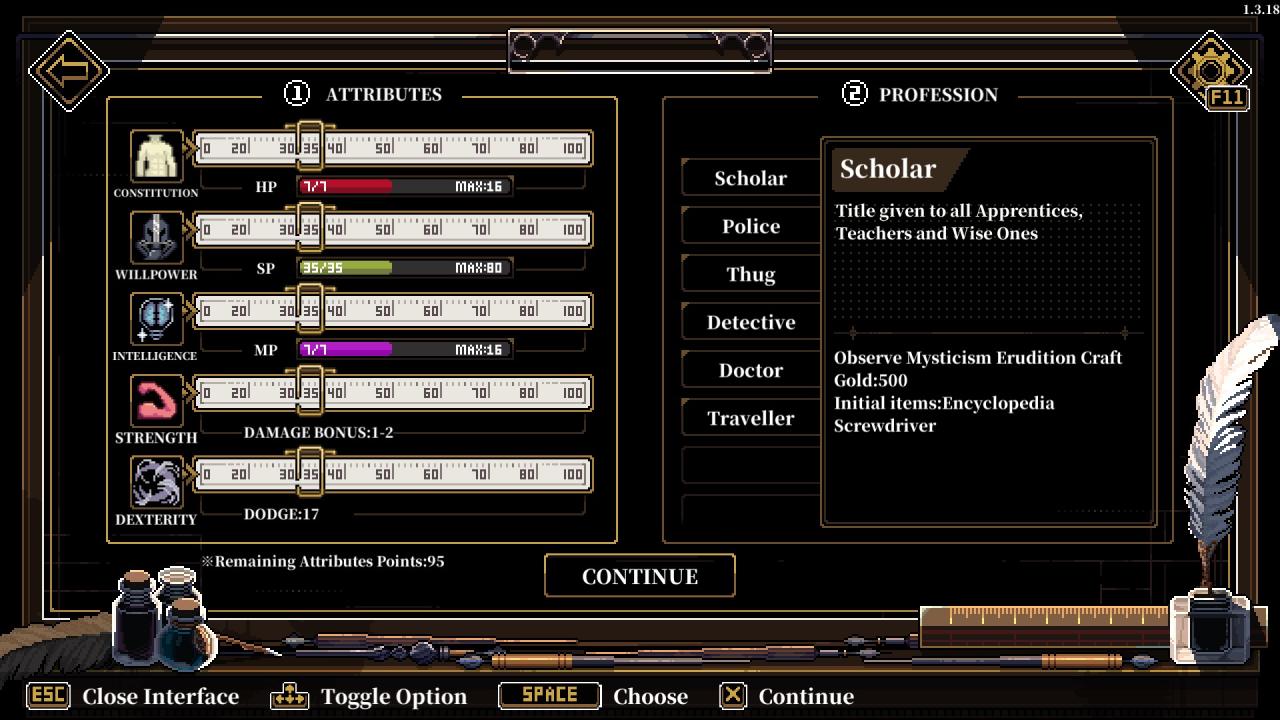
The first page is pretty straightforward. The fighting stats + the roles.
Note that you are some of the dice rolls are based on these stats, but way less than the rest, and both array of stats are completely independent from one another.
For the beginner’s build here’s what I recommend:
-50% in HP (10)
-60% in SP (60)
-50% in MP (10) (You need ten for this build)
-60% in Dmg (1-3)
-50% in Dodge (25)
Then pick the Scholar job/class, seen in the image.
It is a good class to get familiar with every aspect of the game. (I’ll talk about the others later)
Obviously if you want a purely physical build drop MP for max Dmg and Constitution/Dodge.
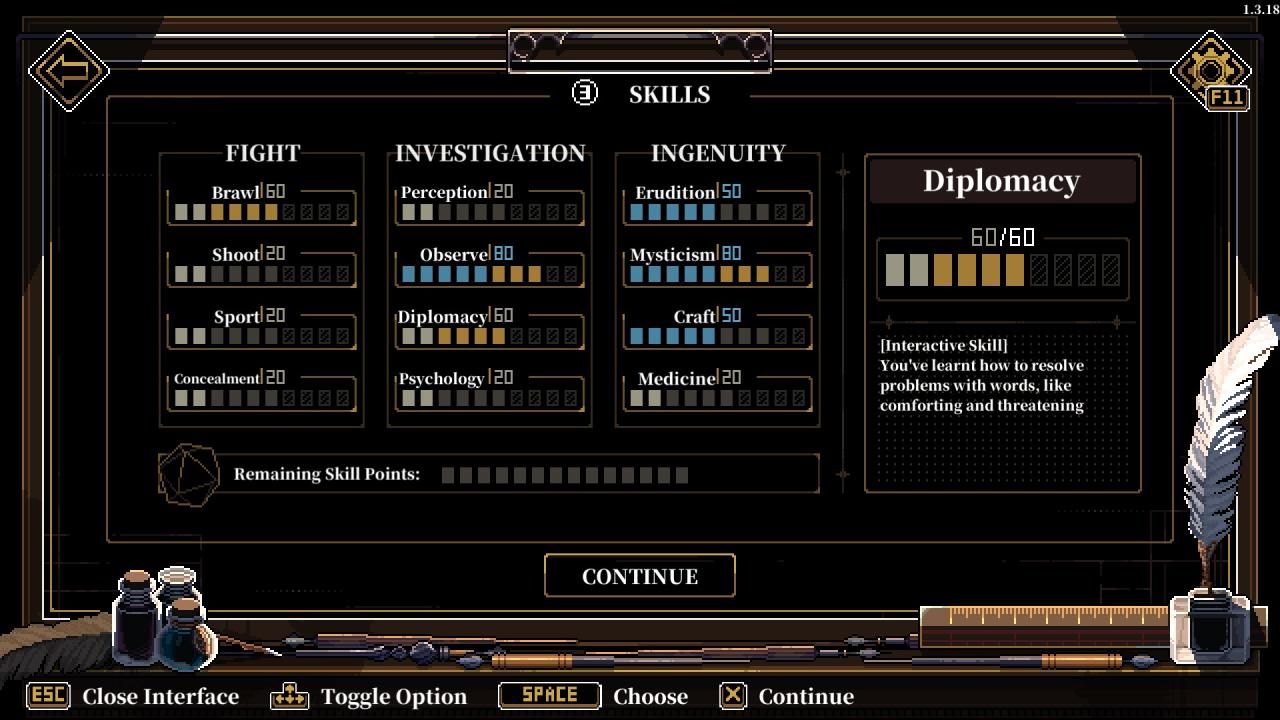
After selecting your class and fighting stats, you’ll be confronted with the skill tree. The blue points are your job affinity that you can max to 80. The other stats can be base maxed to 60.
Since I’m teaching you the Phy/Magic Scholar build, I think these are the best stats.
Depending on the level, Diplomacy is more or less important but the other three are goated:
–Observation because you’ll need to find every secrets for the different endings.
–Brawl for physical damage and weapon that do not need reload or limited ammo.
–Mysticism for Magic Related damage and Spells.
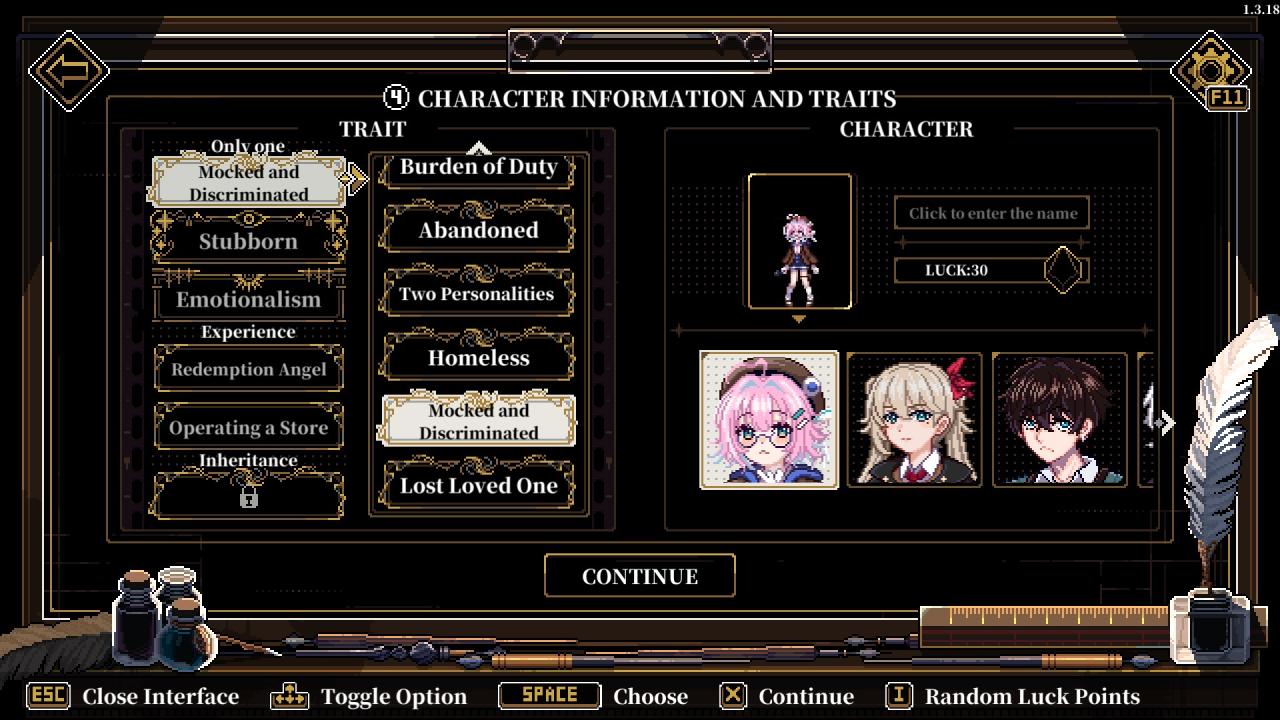
Finally you need to pick an appearance, a name, the base reserve of luck (randomized by pressing i or clicking on it, the max is 90 but it’s very rare so don’t waste too much time, 60 is enough), and the different traits of your character.
This is where I’m really disappointed. (Personally)
Here’s how it works:
-The first trait is an “origin” that will affect your characters. (I suggest picking “Left to Fate” because it has no real negative bearing and can even help you lend critical success.)
-The second is your character’s main personality flaw which will lock certain options of dialogues. To give you an idea on how bad it can be, if you pick Impulsive, Hatred or Vanity, you can’t complete Welcome to Townsend without spending extra resources. (Pretty sure Careful is also a soft lock if you don’t have said resources) (Not even have a dull ending, no you just get a bad ending and can’t bypass it because your character will not stop a key murder from happening.) If you pick Arrogant and this is your first character, you’re encouraged to pick a fight that could be unwinnable depending on your build. (Since you’re stuck at 1 hp with a fracture)
Advice? Always pick Stubborn. (It gives you the most freedom and the rest are standard Shounen Protagonist stuff so you’re good. It’s sad but it’s like that.)
Complementary information from Aviator:
When you get locked out of a dialog option because of your second trait. You can click on the locked dialog and spend 10 sp points to unlock it and avoid getting locked out of an ending. No where does it say this in game but I thought i’d just share it here
This whole situation just reinforces how weird and pointless picking anything other than “Stubborn” is…. That’s honestly pretty sad, but hopefully the other campaigns can shed light on this issue.
Now back to the character creation:
–The third is your way of life/ideology. The game precises when an answer corresponds to your way of life and if you answer that, you get bonus SP, very valuable. Although sometimes depending on what you picked, you might have to go against that ideology to get a good ending. (No matter if it’s a “good” or “bad” one.)
Finally you have the “Experience” and “Inheritance”. Again, for your first character, pick something that has no real relation to your direct stats, otherwise most dice rolls will be harder to do. “Windfall”, “Self change”, “Operating a store”. You can also pick “Fake Identity” if you don’t consider the items of your selected job valuable. Don’t for this build. (By the way the difference between “Wake” and “Sleep”, if I understood correctly, is that “Wake” is during a campaign and “Sleep” is outside of it, during the side stories.)
As for the “Inheritance”, it’s every traits you have unlocked during a campaign. Some are really op like “Panacea” or “Interacting with Cult”, the latter for our build. You can get multiple, and even traits that are available right from the start. (Don’t pick Windfall if you’re trying to get the good ending of Liars and Fraud, since you’ll get it here anyway, so go with “Self change” and “Operating a store”.)
Follow these tips and there you go! You got a good strong protagonist to get familiar with the game and that can work in any scenario. Obviously the plot wants you to start with Liars and Fraud, but if you don’t like the cult, play Welcome to Townsend and get the amulet of Wende, not telling how, but it’s seriously going to give you a good boost to your already crazy magic damage. (With mystical dagger + wait a bit and get the other buff for bladed weapon and magic damage.)
As for the other roles: I think they all good perks and advantages, I’m pretty sure someone better than me is going to find really broken stuff, but I do have some criticism.
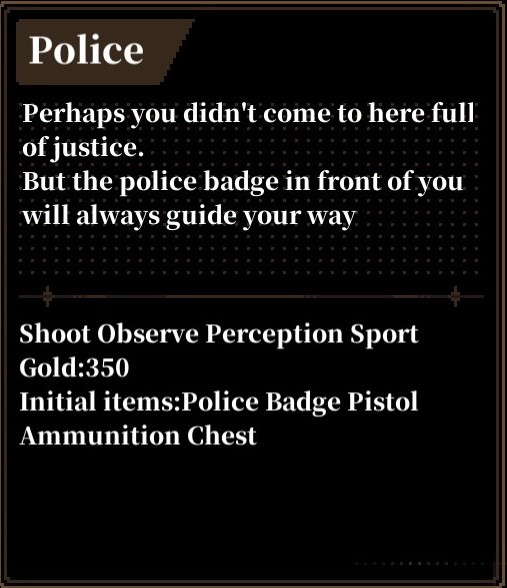
The police badge is excellent and using the cop’s pistol as a buff in your off-hand does some serious damage. Sadly the ammo capacity is really limiting and there’s very low chance you’ll end up having enough to get the best possible ending with your first run. (I did manage an okay one, but I was almost stuck in an impossible fight so don’t forget to save.)
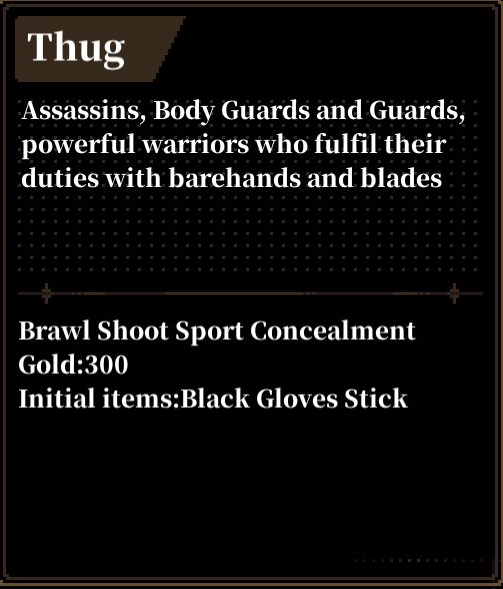
The first class I tested. The starting weapon is okay, although you can get much better fast, and the high brawl damage and sport for climbing is nice. However, put some observation point if you’re trying to play it, also don’t hyper-specialize in all of the fighting abilities, otherwise you’ll get stuck in a bad end.
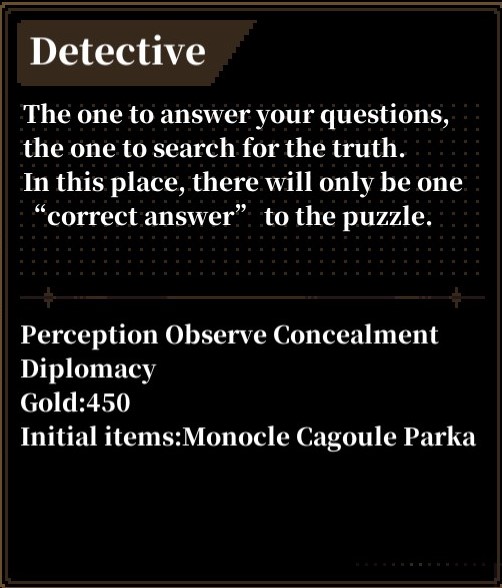
I personally think this class is too frail. Every item deduces constitution. It is excellent as a scout to try and get as many secrets as possible in your first run, but if you don’t put anything in fighting, you’re ♥♥♥♥♥♥.
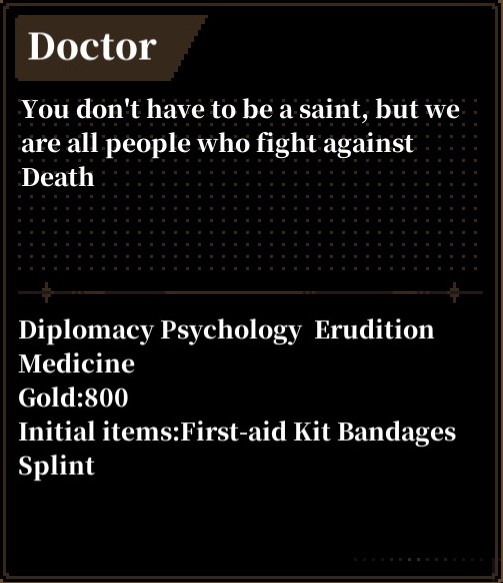
High medicine and heal is really nice but in two out of three campaigns, you’re mostly on your own. So healing outside of combat is good, however you need to be able to fight or run away.

Starting with the most money isn’t really useful to be honest. The hiking boots and huge diplomatic skill is excellent to resolve conflict peacefully, but again, you’ll have to fight at some point.
